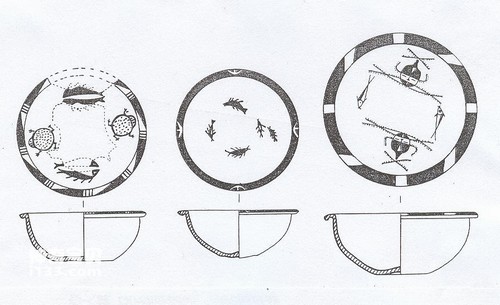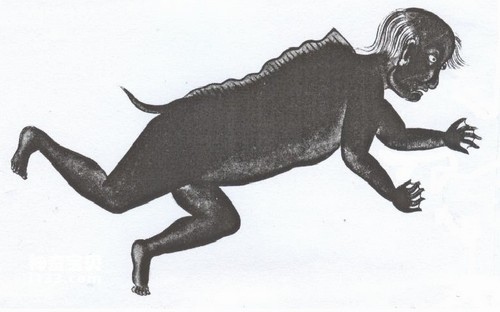Our country is one of the earliest countries in the world to utilize fish. Fish has long been used as food and has become an important dependence for people's survival. Since ancient times, people have had an indissoluble bond with fish, and the painted pottery art of the Neolithic Age has shown the worship of totem fish. Totem, whose English name is Totem, comes from primitive peoples such as North American Indians. It is a natural object, especially an animal, that is closely related to its family. This article introduces the long history and rich connotation of totem fish in my country from three aspects: totem fish in the Neolithic Age, totem fish in ancient Chinese books, and totem fish in ethnic and folk customs.
1. Totem fish of the Neolithic Age
Among the painted pottery art of the Neolithic Age that has been excavated in my country, there are more than 20 sites where totem fish appear. Among them, the painted paintings of the Banpo-type Yangshao Culture are the most abundant. They are basically fish patterns and modified fish patterns. The painted pottery decoration is a specific A symbol of people's community, it exists in most cases as a clan totem or other symbol of worship. The "human face and fish pattern" painted pottery found in sites such as Banpo in Xi'an, Jiangzhai in Lintong, Beishouling in Baoji, and Nanzheng in the Han River have a distinct totemic nature, which gave rise to the worship of fish.

Figure 1: Several totem fish symbols in the primitive settlement of Jiangzhai (quoted from: Gao Qiang 1984 "Prehistoric Research")
Now take several totem fish symbols in the original settlement of Jiangzhai, Lintong, Shaanxi Province (Figure 1, quoted from "Prehistoric Research" by Gao Qiang 1984) as an example. Figure 1. On the left is an unearthed pottery basin with a fish and frog pattern. They are all black bodies, in the shape of a complex, and combined with frogs, the two phases are symmetrical. Figure 1. shows a painted pottery basin with a five-fish pattern that was buried with the body. The five fish are all swimming with their mouths open, which is lifelike. Two of the symmetrical tails have a black back and a white belly, and the rest are all black bodies. Figure 1. Right, two unearthed painted pottery basins with human face patterns. The human face patterns are combined with fish, and they are painted on the inner walls of the pottery basins in pairs. The fish patterns are all black, with a black back and a white belly. The human facial pattern is rather special. The human face is round or oval, with basic facial features such as eyes, nose, and mouth, just like a real person's face. The head is also decorated and the hair is tied on top of the head. Two long intersecting lines are drawn on both sides of the mouth, and some small dots or thorn-like decorations are added. This is an abstract representation of the body of the fish. The following pieces of pottery excavated by archaeologists illustrate the understanding of prehistoric ancestors about the origin of human beings, and they believed that they were the offspring of the marriage between man and fish.
2. Totem fish in ancient Chinese books
It is said that the author of "The Book of Mountains and Seas" is Dayu (reigned 2205-2198 BC) and others. It is the earliest geography book and human geography in my country. It is also a unique ancient book that collects ancient local myths. There are many records of totem fish in the book, here are a few examples: "The Great Wilderness Western Classic" "There is a country of Hu (family), the grandson of Emperor Yan is named Ling, and the spirit of Hu (family) people can go up and down to the sky"; "Hainei Nanjing" "The country of Shiren is built in Muxi. It is human, with a human face and a fish body, and no legs." (Note: The shape of Shiren country is a human face and a fish body. It can ride on clouds and rain up and down in the sky. , is a totem god that is a combination of human and fish. This shows that the fish totem is a kind of totem in Emperor Yan).
"The Western Classic of the Great Wilderness" "There is a fish named Fish Woman. When Zhuanxu dies, he will revive. The wind comes from the north, and Yao is a big spring. The snake turns into a fish, which is the fish wife. Zhuanxu will revive after death." (Note: Legend has it that Zhuanxu was the name of an ancient emperor).
The Book of Songs, written in the 25th century BC, no later than the 6th century BC, is a collection of ancient one-step ballads with an unknown author. It was compiled by Confucius (552 BC - 469 BC) in the Spring and Autumn Period, who selected 305 poems from more than 3,000 ancient poems, including 21 poems about fish. Here is an example from "Xiaoya No Sheep", "The shepherd is a dream": Zhongwei is a fish, but Haowei is a fish. The master said: "If there are many fishes in all dimensions, it will be a good year. If there are no dimensions, the family will be in harmony." (Note: This is the result of a dream. There are many fish in the water in the dream, which is a symbol of a good harvest. Dreaming about flags with turtles, snakes and birds is a harbinger of prosperity.) The dream imagery in the poem is related to having children and people. Ding is prosperous and has a good harvest. The fish and flag here are the manifestations of primitive totems in dreams.

Picture 2: Mermaid (quoted from: "The Pictures of the Qing Palace and the Sea" edited by Nie Huang)
"The Map of the Sea in the Palace of the Qing Dynasty" was compiled by Nie Huang during the reign of Emperor Kangxi (AD 1698), and included a total of 233 marine species, including 98 species of fish (Biological Bulletin by Zhang Shiyi and Shang Xiuqing in 2012). About "Mermaid": "Mermaid is as long as a human, with black and yellow flesh. It has hands, feet, eyebrows, eyes, mouth and nose, and its yin and yang are the same as those of men and women. But it has wings on its back, red, and a short tail and calloused fingers behind it, which is similar to People have slightly different ears." Liu, a native of Guangdong, once made plans for me, but I never believed in him. According to "Zifang Waiji", this fish is called "Hai Ren", "Zheng Zi Tong" is "Yu Ren", the cloud is () fish, and the description is the same as the picture. Recorded on faith. This fish is abundant in Dayu Mountain and Laowan Mountain in Guangdong. People living in the sea can get it and eat it, but they can't speak, they can only laugh. Take it to Dayu Mountain and submerge it into the water. Guo Pu has "Ode to the Mermaid". "Guangdong News" says that when there is strong wind and rain in the sea, mermaids ride on big fish and go with the waves, and those who see them are surprised. There is a wish from the fire leader: "Don't meet the sea maidens, don't see the mermaids." "Ode to the Mermaid" The fish is named after a person and has all its hands and feet. It has a short tail, dark skin, and a mane on its back.
3. Totem fish in ethnic and folk customs
There are many examples of fish as totems in Chinese folk customs. Here are a few examples.
In ancient times, some Bai people used fish as their totem, and they took "Yu" as their surname (called "Wuci" in Bai people's language). Later, after frequent interactions with the Han people, they learned from the Han surnames Zhang, Wang, Li, Zhao, etc., and changed the name "Yu" to "Yu". The surname was changed to "Yu". In modern times, the Bai people still retain many customs of fish totem worship. For example, Bai women in many villages around the Erhai Lake in Yunnan use fish tail hats as headdresses. They are made of black or golden cloth imitating the shape of a fish. The fish head is in front and the tail is in the back, with white silver bubbles or white beads on it to represent fish scales. After death, there is a custom of burying fish and conches with them.
It is said that fish are the ancestors of some Buyi people. Some of them married the girl who was the incarnation of a flower fish and multiplied the myth of their tribe. There is still the custom of fish totem worship. After a person dies and is buried, the tombstone is engraved with a Pisces gourd pattern. During a wedding, a picture of a full moon and Pisces is painted on the back of the sedan chair the bride rides in to show good luck.
Most Manchu surnames are the names of totems, such as Nimaha, which means fish. This is just like the Indian clans. The so-called Yu clan was originally a clan with fish as its totem. Later, the clan name gradually evolved into a surname (He Xingliang 1996 "Central Plains Cultural Relics").
The Shui people are an ethnic minority with a long history in southern my country. They mainly live in the southeastern part of Guizhou Province. Fish is the most important thing worshiped by the aquarium people, and it is the shadow of the ancestors of the aquarium people. From the ancestor worship, mourning and wedding customs of the Shui tribe, it can be seen that the Shui tribe has a close relationship with fish (Pan Chaolin 2001 "Guangxi Ethnic Research").
Among the totem fish in my country, fish or fish patterns symbolize fertility, fertility, and wealth. In addition, the homophonic factor (fish and surplus) plays an important role. For example, fish pictures and decorations have auspicious fish such as "Lucky and surplus (fish)" and "Every year there is surplus (fish)". Totem fish were mentioned more often in ancient times than in modern times. However, people's admiration and love for fish have not diminished, and they regard fish as mascots, which means "good luck, prosperity, wealth", etc. The colorful ornamental fish raised in park attractions and thousands of households increase the beauty of nature. Let people enjoy peace and prosperity.
animal tags: fish totem mermaid
We created this article in conjunction with AI technology, then made sure it was fact-checked and edited by a Animals Top editor.